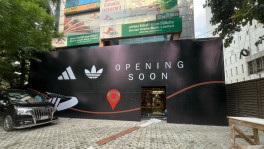King Charles, William and Harry reunited in grief to escort queen's coffin

Summary
- Queen's coffin taken from palace to parliament
- Archbishop of Canterbury conducts short service
- Four days of lying in state, large queue forming
- King and senior royals followed coffin
King Charles, his sons Princes William and Harry and other senior royals joined a solemn procession taking Queen Elizabeth's coffin as the late monarch made her final journey from Buckingham Palace on Wednesday.
Huge crowds gathered in central London to witness the queen being taken from the palace to parliament as artillery guns fired salutes and Big Ben tolled, the latest in a series of poignant ceremonies as the nation mourns the queen who died last week aged 96 after seven decades on the throne.
Lying on a gun carriage, covered by the Royal Standard flag and with the Imperial State Crown placed on a cushion on top alongside a wreath of flowers, the coffin bearing Elizabeth's body was taken in a slow, sombre procession from her London home to Westminster Hall. There it will lie in state for four days.
Walking directly behind were Charles and his siblings, Anne, Andrew and Edward.
In a group that followed were Charles's sons Princes William and Harry, a doleful scene reminiscent of when, as boys 25 years ago, they followed the casket of their mother Princess Diana when it was taken on a similar procession through central London.
It was also a symbolic show of unity as William, 40, now the Prince of Wales, and Harry, 37, the Duke of Sussex, are said to be barely be on speaking terms after a bitter falling out in the last couple of years.
"It was very moving, seeing the family. It was a powerful show of unity," said Jenny Frame, 54, who waited for more than four hours to see the procession. "I think it's the very best of British and ... very fitting for her."
Husged silence
A military band playing funeral marches and soldiers in ceremonial scarlet uniforms, some with shiny silver breastplates and helmets, accompanied the gun carriage pulled by the King's Troop, Royal Horse Artillery, as it moved slowly through central London, where many roads were closed to traffic.
Guns fired every minute at Hyde Park, while parliament's famous Big Ben bell also rang at 60-second intervals. The crowds stood in a hushed silence as they watched the procession but then broke into spontaneous applause when it passed. Some threw flowers.
Other senior royals including Charles' wife Camilla, now the Queen Consort, Kate, William's wife and now Princess of Wales, and Harry's wife, Meghan, travelled by car.
When the procession reached Westminster Hall, a medieval building with origins dating back to 1097 and the oldest part of the Palace of Westminster that houses the British parliament, the coffin was carried inside by soldiers from the Grenadier Guards and placed on a catafalque surrounded by candles.
A short service followed, conducted by the Archbishop of Canterbury, the spiritual head of the Anglican Church, as senior politicians watched on. The royals quietly departed, with Harry and Meghan holding hands.
From around 5 p.m. the public will be allowed to file by in a constant stream, 24-hours a day, during four days of lying in state that will continue until the morning of the funeral on 19 Sept.
A constant vigil will be held by soldiers in full ceremonial uniforms at the four corners of the catafalque.
A Buckingham Palace spokesperson said Elizabeth had three keys roles in her life: head of the family, head of the nation and head of state. Wednesday marked the moment the coffin passed from the family to the state.
"I don't think we'll see anything like that again ever, or a queen like that again," said Paul Wiltshire, 65, among the crowd for the procession. "An end of an era."
Long queue
People started waiting in line late on Tuesday, sleeping on the street in the rain, to be one of the first to file past the coffin, and there was already a queue some two miles long.
"We didn't even think about it," said Glyn Norris, 63, adding a bit of rain would not deter her. "That was my queen."
Among those gathered, some were there to represent elderly parents, others to witness history and many to thank a woman who, having ascended the throne in 1952, was still holding official government meetings just two days before she died.
The government has warned the queue could stretch for up to 10 miles (16 kilometres) along the southern bank of the River Thames, winding past landmarks such as the giant London Eye ferris wheel and a reconstruction of Shakespeare's Globe theatre.
Culture Secretary Michelle Donelan said some people might have to stand in line for as long as 30 hours in order to file past the coffin before Monday's funeral.
"She's an icon of icons," mourner Chris Imafidon said. "I must at least endure this camping out of respect."
Speaking to people in the queue, the Archbishop of York Stephen Cottrell, quipped: "We are honouring two great British traditions, loving the queen and loving a queue."
Elizabeth's coffin was flown back London late on Tuesday from Scotland, where it had been since her death at her Scottish summer holiday home Balmoral Castle, with tens of thousands of people lined the 14-mile (22 km) route in driving rain.
In Scotland, about 33,000 people filed past the coffin during the 24 hours it was at St Giles' Cathedral in Edinburgh, but the memorial in London is a much larger occasion.
As many as 750,000 mourners are expected to walk through Westminster Hall to pay their final respects.
A senior palace official described Wednesday's poignant pageant as relatively small and personal. The full-scale ceremonial procession on the day of her funeral is likely to be one of the biggest the country has ever witnessed.
Royalty, presidents and other world leaders are expected to attend, although no one from certain nations, such as Russia, Afghanistan, and Syria will be invited.
U.S. President Joe Biden, who has said he would be there, spoke to the new king earlier on Wednesday, the White House said, and "conveyed the great admiration of the American people for the Queen".


 Keep updated, follow The Business Standard's Google news channel
Keep updated, follow The Business Standard's Google news channel
















